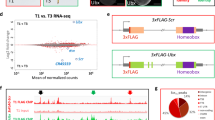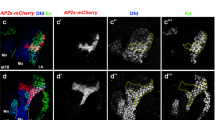Abstract
Homeobox genes specify cell fate and positional identity in embryos throughout the animal kingdom1. Paradoxically, although each has a specific function in vivo, the in vitro DNA-binding specificities of homeodomain proteins are overlapping and relatively weak. A current model is that homeodomain proteins interact with cofactors that increase specificity in vivo2,3. Here we use a native binding site for the homeodomain protein Fushi tarazu (Ftz) to isolate Ftz-Fl, a protein of the nuclear hormone-receptor superfamily and a new Ftz cofactor. Ftz and Ftz-Fl are present in a complex in Drosophila embryos. Ftz-Fl facilitates the binding of Ftz to DNA, allowing interactions with weak-affinity sites at concentrations of Ftz that alone bind only high-affinity sites. Embryos lacking Ftz-Fl display ftz-like pair-rule cuticular defects. This phenotype is a result of abnormal ftz function because it is expressed but fails to activate downstream target genes. Cooperative interaction between homeodomain proteins and cofactors of different classes may serve as a general mechanism to increase HOX protein specificity and to broaden the range of target sites they regulate.
Similar content being viewed by others
References
McGinnis, W. & Krumlauf, R. Cell 68, 283–302 (1992).
Hayashi, S. & Scott, M. P. Cell 63, 883–894 (1990).
Mann, R. S. & Chan, S.-K. Trends Genet. 12, 258–262 (1996).
Wakimoto, B. T., Turner, F. R. & Kaufman, T. C. Dev. Biol. 102, 147–172 (1984).
Pick, L. Scheir, A., Affolter, M., Schmidt-Glenewinke, T. & Gehring, W. J. Genes Dev. 4, 1224–1239 (1990).
Laughon, A. Biochemistry 30, 11357–11367 (1991).
Struhl, G. Nature 318, 677–680 (1985).
Hiromi, Y. & Gehring, W. J. Cell 50, 963–974 (1987).
Schier, A. F. & Gehring, W. J. Nature 356, 804–807 (1992).
Yu, Y. & Pick, L. Mech. Dev. 50, 163–175 (1995).
Han, W., Yu, Y., Allan, N. & Pick, L. Mol. Cell. Biol. 13, 5549–5559 (1993).
Ueda, H., Sonoda, S., Brown, J. L., Scott, M. P. & Wu, C. Genes Dev. 4, 624–635 (1990).
Lavorgna, G., Ueda, H., Clos, J. & Wu, C. Science 252, 848–851 (1991).
Ohno, C., Ueda, H. & Petkovich, M. Mol. Cell. Biol. 14, 3166–3175 (1994).
Ayer, S. et al. Nucl. Acids Res. 21, 1619–1627 (1993).
Maier, D., Preiss, A. & Powell, J. R. EMBO J. 9, 3957–3966 (1990).
Perrimon, N. A., Lanjuin, C., Arnold, E. & Noll, E. Genetics 144, 1681–1692 (1996).
Han, W., Yu, Y., Kohanski, R. A., & Pick, L. J. Biol. Chem. (submitted).
Fitzpatrick, V. D. & Ingles, C. J. Nature 337, 666–668 (1989).
Hyduk, D. & Percival-Smith, A. Genetics 142, 481–492 (1996).
Copeland, W. R., Nasiadka, A., Dietrich, B. H. & Krause, H. M. Nature 379, 162–165 (1996).
Guichet, A. et al. Nature (this issue).
Furukubo-Takunaga, K. et al. Genes Dev. 6, 1082–1096 (1992).
Rauskolb, C., Peifer, M. & Wieschaus, E. Cell 74, 1101–1112 (1993).
Ikeda, Y. et al. Mol. Endocrinol. 7, 852–860 (1993).
Krause, H. M., Klemenz, R. & Gehring, W. J. Genes Dev. 2, 1021–1036 (1988).
Treisman, J., Gonczy, P., Vashishtha, M., Harris, E. & Desplan, C. Cell 59, 553–562 (1989).
Chou, T.-B. & Perrimon, N. Genetics 144, 1673–1679 (1996).
Hiromi, Y., Kuroiwa, A. & Gehring, W. J. Cell 43, 603–613 (1985).
Author information
Authors and Affiliations
Rights and permissions
About this article
Cite this article
Yu, Y., Li, W., Su, K. et al. The nuclear hormone receptor Ftz-F1 is a cofactor for the Drosophila homeodomain protein Ftz. Nature 385, 552–555 (1997). https://doi.org/10.1038/385552a0
Received:
Accepted:
Issue Date:
DOI: https://doi.org/10.1038/385552a0
- Springer Nature Limited
This article is cited by
-
A single transcription factor facilitates an insect host combating Bacillus thuringiensis infection while maintaining fitness
Nature Communications (2022)
-
Oncopeltus-like gene expression patterns in Murgantia histrionica, a new hemipteran model system, suggest ancient regulatory network divergence
EvoDevo (2020)
-
Transcription factor FTZ-F1 regulates mosquito cuticular protein CPLCG5 conferring resistance to pyrethroids in Culex pipiens pallens
Parasites & Vectors (2020)
-
Non-specificity of transcription factor function in Drosophila melanogaster
Development Genes and Evolution (2017)
-
Hox genes, evo-devo, and the case of the ftz gene
Chromosoma (2016)





